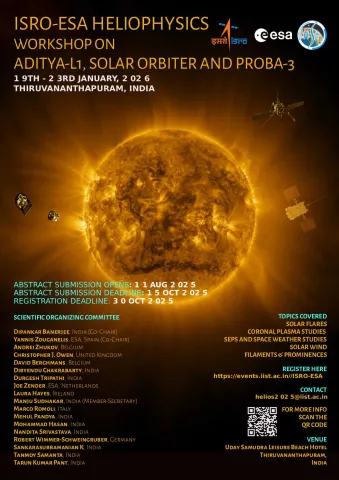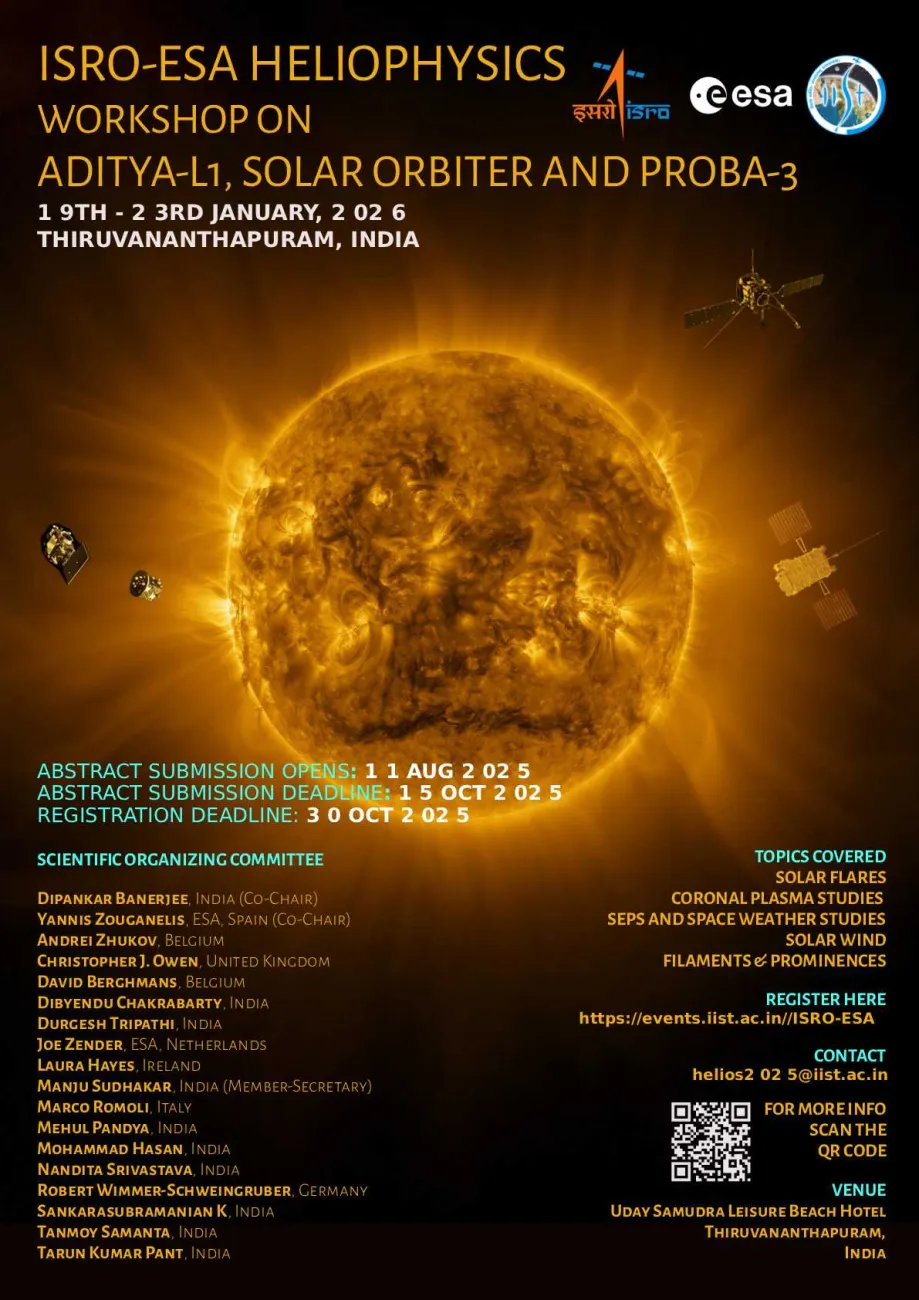ISRO-ESA Heliophysics Workshop on Aditya-L1, Solar Orbiter and Proba-3
The Indian Space Research Organisation (ISRO) and the European Space Agency (ESA) are excited to announce a joint workshop focused on heliophysics. The workshop aims to bring together scientists working with data from Aditya-L1, Solar Orbiter, and Proba-3 missions to explore new scientific opportunities by combining data from these three missions.
With the unprecedented solar and heliospheric observations currently available from these three missions, the workshop will leverage the unique vantage points and orbits of these missions to enhance our understanding of the Sun and heliosphere. The combined data from these missions would provide a comprehensive view that surpasses the capabilities of individual missions.
This workshop will serve as a platform for the heliophysics scientific community, preferably working with the science data of these three mission, to develop strong synergies and collaborative efforts in the area of heliophysics. By fostering this partnership, we aim to advance our knowledge of the Sun and its impact on the heliosphere.
Aditya-L1: India's (ISRO’s) first dedicated solar space mission, launched on September 2, 2023, and successfully placed in a halo orbit around the first Earth-Sun Lagrange point (L1) on January 6, 2024. This mission aims to study the Sun from a unique vantage point, Sun-Earth Lagrangian L1 point which is 1.5 million kilometers away from Earth, providing continuous, unobstructed observations. Experiments cover – near simultaneous chromospheric Imaging in multi-band, coronal imaging in green coronal emission line, Sun-as-a-star soft- and hard X-ray spectroscopy, In-situ charged particles and magnetic field measurement. https://www.isro.gov.in/Aditya_L1.html
Solar Orbiter (SO): Solar Orbiter is a mission of international cooperation between ESA and NASA, launched in February 2020 and operated by ESA. It is the most complex scientific laboratory ever to have been sent to our star, taking images of the Sun from closer than any spacecraft before and being the first to look at its polar regions. With Solar Orbiter's ten instruments, scientists try to answer some profound questions: What drives the Sun’s 11-year cycle of rising and subsiding magnetic activity? What heats up the upper layer of its atmosphere, the corona, to millions of degrees Celsius? How does solar wind form, and what accelerates it to speeds of hundreds of kilometres per second? And how does it all affect our planet? https://www.esa.int/Science_Exploration/Space_Science/Solar_Orbiter
Proba-3: Proba-3 is an ESA mission focused on demonstrating precise formation flying of two spacecraft to achieve a unique scientific goal: creating an artificial solar eclipse in space. Launched on December 5, 2024, on an ISRO PSLV rocket, the mission aims to study the Sun's innermost corona with unprecedented clarity by blocking out the Sun's bright disk. A secondary scientific payload (DARA) is hosted on the OSC. DARA stands for "Davos Absolute Radiometer" and is an absolute radiometer for measuring total solar irradiance (TSI). The high-fidelity 3D Energetic Electron Spectrometer (3DEES) is embarked as atechnology demonstration. (https://www.esa.int/Enabling_Support/Space_Engineering_Technology/Proba_Missions/Proba-3_Science_payloads)
About the Workshop:
The workshop will have a number of invited presentations from eminent scientists in the area of solar and heliophysics relevant to the three missions (Aditya-L1, Solar Orbiter, and Proba-3). Three half-day sessions on science data processing and associated guidance will be provided by relevant instrument teams. There will be opportunities to work on specific problems using data from these missions—specifically addressing combined science analysis. Limited contributed and poster presentations are also encouraged. Preliminary results will be presented in the final session, paving the way for future collaborations.
Photo Gallery
Venue
Uday Samudra Leisure Beach Hotel
GV Raja Road, Samudra Beach, Kovalam, Thiruvananthapuram 695527
Website Url
Contact Person
Event Details
-
Mode:In-Person




